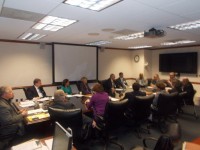County Lawmakers, Utility Reps Hash Out Storm Improvements

County legislators last week quizzed representatives from the two electric utilities that serve Westchester in hopes of learning what changes the beleaguered companies intend to make to address the deficiencies following Hurricane Sandy.
The two-hour session on Dec. 4, led by legislators Michael Kaplowitz (D-Somers) and Catherine Borgia (D-Ossining), the chairs of the Board of Legislators’ Environment and Energy and Government Operations committees, respectively, heard officials from Con Edison and New York State Electric & Gas acknowledge that equipment upgrades and the flow of information to municipal officials and the public must improve in future storms where widespread outages are likely.
However, officials from the utilities said that there were factors connected to Hurricane Sandy that would have kept large swaths of the county in the dark for extended periods regardless of the effectiveness of preparation. Con Edison had to replace more than 650 utility poles countywide and deal with more than 1,000 closed roads in their area at the height of the outages, said Tony Suozzo, Con Edison’s public affairs manager.
NYSEG, whose territory stretches from northern Westchester to the Canadian border, had to redeploy workers from the northern and western parts of the state, then had to address 800 broken poles and more than 5,200 downed wires.
“Clearly, the model we operated under (Hurricane) Sandy needs to be upgraded,” said John Banks, Con Edison’s vice president of government operations. “This storm was so huge that what it was designed to do was clearly inadequate.”
Banks and John Salmon, NYSEG’s manager of outreach and development in the eastern region, concurred that their companies could not get line workers from utilities in nearby states as they typically do. Due to the size of the storm, about one-fifth of the electric companies in the United States, including nearly all in the northeast, did not release workers until it was certain they weren’t needed in their home regions. As a result, line workers from as far away as California had to be brought in, Banks said.

Martin has more than 30 years experience covering local news in Westchester and Putnam counties, including a frequent focus on zoning and planning issues. He has been editor-in-chief of The Examiner since its inception in 2007. Read more from Martin’s editor-author bio here. Read Martin’s archived work here: https://www.theexaminernews.com/author/martin-wilbur2007/
